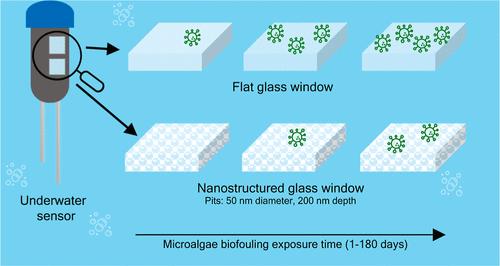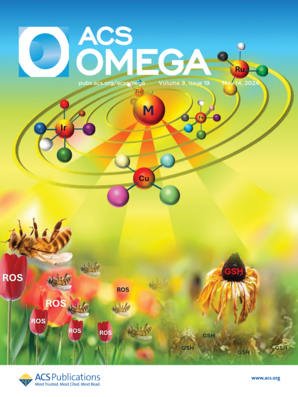Transparent, Antibiofouling Window Obtained with Surface Nanostructuring
IF 3.7
3区 化学
Q2 CHEMISTRY, MULTIDISCIPLINARY
引用次数: 0
Abstract
Biofouling is one of the key factors which limits the long-term performance of seawater sensors. Common measures to hinder biofouling include toxic paints, mechanical cleaning and UV radiation. All of these measures have various limitations. A very attractive solution would be to prevent biofilm formation by changing the surface structure of the sensor. This idea has been implemented successfully in various settings, but little work has been done on structuring optically transparent materials, which are often needed in sensor applications. In order to achieve good antibiofouling properties and efficient optical transparency, the structuring must be on the nanoscale. Here, we investigate a transparent, antibiofouling surface obtained by patterning a semihexagonal nanohole structure on borosilicate glass. The nanoholes are approximately 50 nm in diameter and 200 nm deep, and the interparticle distance is 135 nm, allowing the structure to be optically transparent. The antibiofouling properties of the surface were tested by exposing the substrates to the microalgae Phaeodactylum tricornutum for four different time intervals. This species was chosen because it is common in the Norwegian coastal waters. The tests were compared with unstructured borosilicate glass substrates. The experiments show that the nanostructured surface exhibits excellent antibiofouling properties. We attribute this effect to the relative size between the structure and the biofouling microorganism. Specifically, the small dimensions of the nanoholes, compared to the biofouling microorganism, make it more difficult for the microalgae to attach. However, lubrication of the substrates with FC-70 perfluorocarbon resulted in contamination at a rate comparable to the reference substrate, possibly due to the chemical attractiveness of the alkane chains in FC-70 for the microalgae.

利用表面纳米结构获得透明防生物污染窗口
生物污垢是限制海水传感器长期性能的关键因素之一。防止生物污损的常见措施包括有毒涂料、机械清洁和紫外线辐射。所有这些措施都有各种局限性。一个非常有吸引力的解决方案是通过改变传感器的表面结构来防止生物膜的形成。这一想法已在各种环境中成功实施,但在传感器应用中经常需要的光学透明材料结构方面却鲜有研究。为了实现良好的抗生物污染性能和高效的光学透明性,必须在纳米尺度上进行结构化。在此,我们研究了一种通过在硼硅玻璃上图案化半六边形纳米孔结构而获得的透明抗生物污染表面。纳米孔直径约为 50 纳米,深约 200 纳米,颗粒间距为 135 纳米,因此该结构具有光学透明性。通过将基底暴露在微藻类 Phaeodactylum tricornutum 中四个不同的时间间隔,对表面的抗生物污染性能进行了测试。之所以选择该物种,是因为它在挪威沿海水域很常见。测试结果与无结构硼硅酸盐玻璃基板进行了比较。实验结果表明,纳米结构表面具有出色的抗生物污染性能。我们将这种效果归因于结构与生物污损微生物之间的相对尺寸。具体来说,与生物污损微生物相比,纳米孔的尺寸较小,因此微藻更难附着。不过,用 FC-70 全氟碳润滑基底导致的污染率与参考基底相当,这可能是由于 FC-70 中的烷烃链对微藻具有化学吸引力。
本文章由计算机程序翻译,如有差异,请以英文原文为准。
求助全文
约1分钟内获得全文
求助全文
来源期刊

ACS Omega
Chemical Engineering-General Chemical Engineering
CiteScore
6.60
自引率
4.90%
发文量
3945
审稿时长
2.4 months
期刊介绍:
ACS Omega is an open-access global publication for scientific articles that describe new findings in chemistry and interfacing areas of science, without any perceived evaluation of immediate impact.
 求助内容:
求助内容: 应助结果提醒方式:
应助结果提醒方式:


